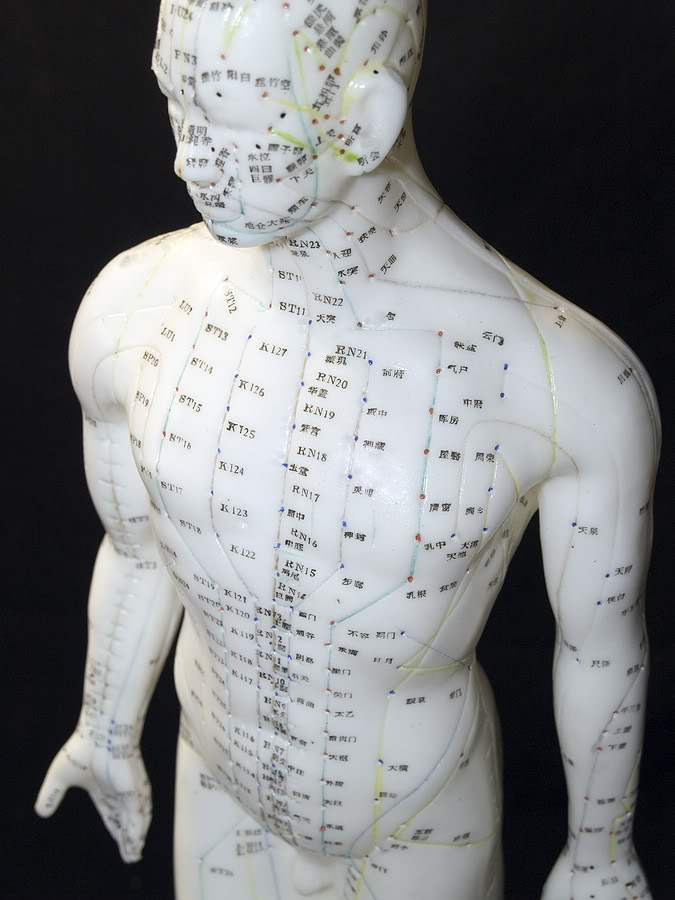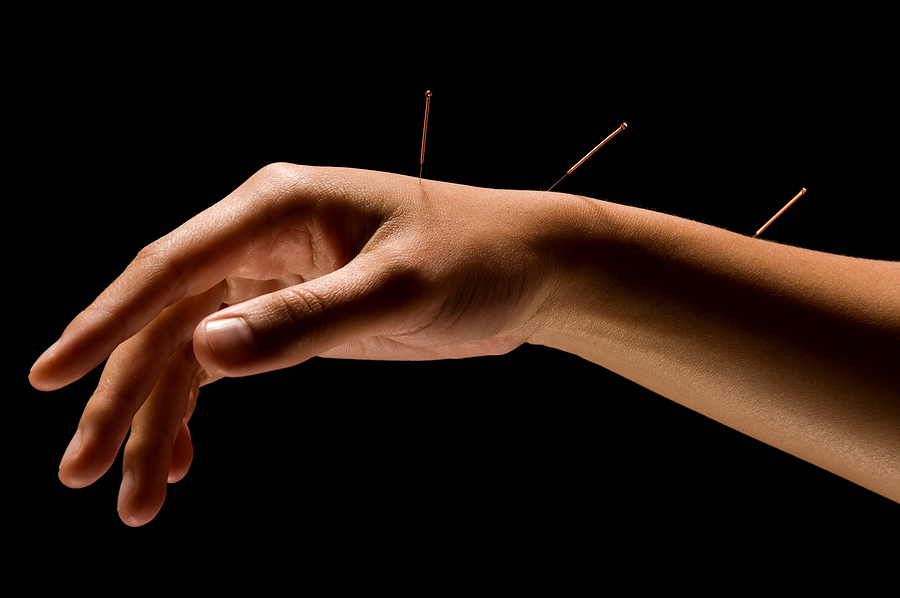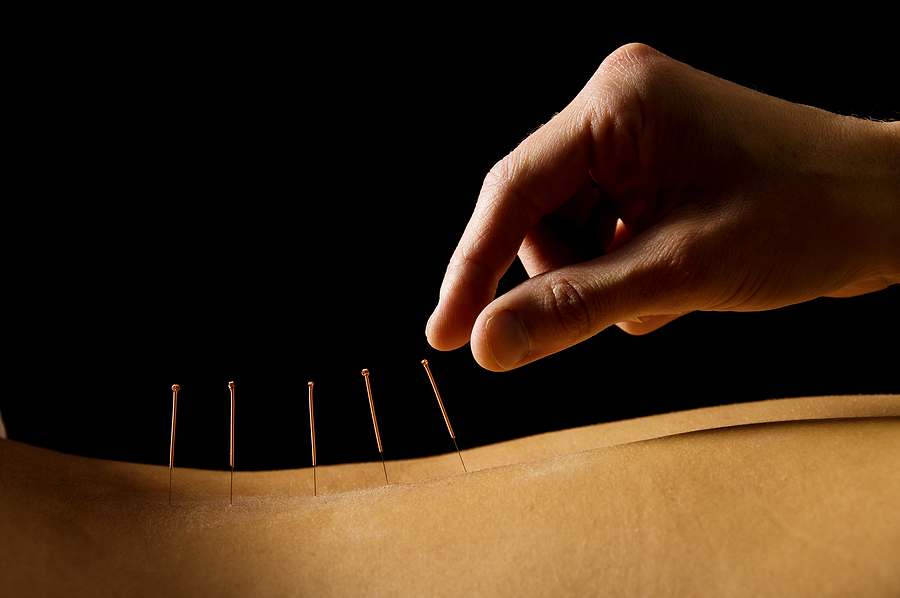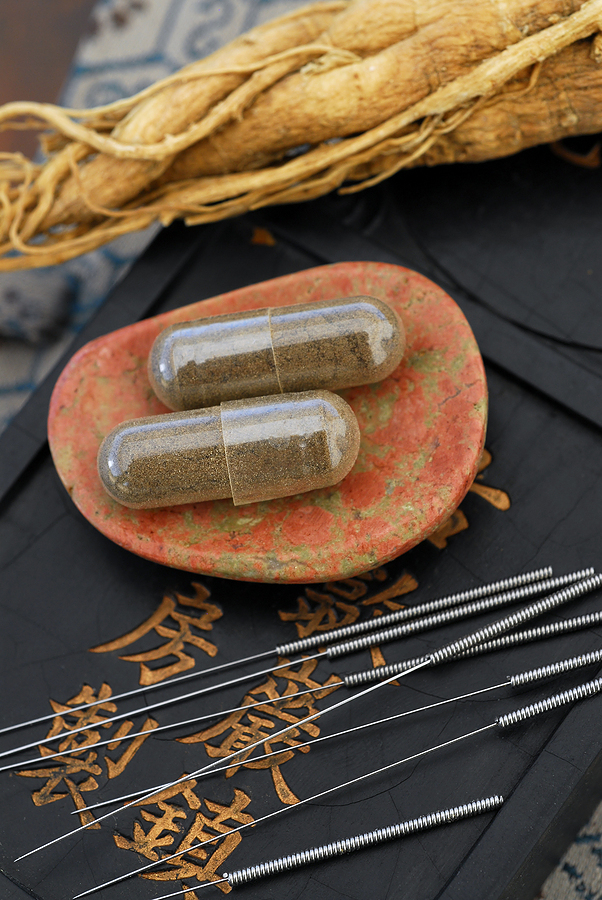Grasping the Wind…The Energy Behind Acupuncture
 In acupuncture charts – probably the closest most Westerners ever come to contacting the Qi concept – the meridian lines you see pictured, show the pathways by which energy flows within us. The points on the meridians where an acupuncturist places his needles are merely spots on the energy grid where the doctor can tinker with the electrical circuitry of an individual’s life force. If you’ve ever had your tennis elbow or sore throat cured by acupuncture, you know that a needle in one part of the body may affect a body part several feet away. This happens because the needle activates your Qi, which then follows a specific meridian path inside your body to its destined target.
In acupuncture charts – probably the closest most Westerners ever come to contacting the Qi concept – the meridian lines you see pictured, show the pathways by which energy flows within us. The points on the meridians where an acupuncturist places his needles are merely spots on the energy grid where the doctor can tinker with the electrical circuitry of an individual’s life force. If you’ve ever had your tennis elbow or sore throat cured by acupuncture, you know that a needle in one part of the body may affect a body part several feet away. This happens because the needle activates your Qi, which then follows a specific meridian path inside your body to its destined target.
One of the things I love about the Chinese approach to the body through acupuncture, is that Body and Mind are not separated, as they are in the West. For example, emotions are said to accumulate in organ systems, impairing the organ’s ability to function. Anger affects the liver, fear affects the kidneys, sorrows lurk in the lungs, frustration harms the spleen. (Many of our old vernacular sayings suggest that Westerners, too, once recognized such connections, as in “needing to vent your spleen” or “being heartsick”.)
The good news is that because of these interconnections, mood, focus, clarity of mind can all improve as a side effect of treating what we perceive to be a physical problem.
There are meridians and “special” meridians, points and organs to be contended with, and the meridians do not refer merely to specific organs but to broader energy concepts unlike any we have in Western Medicine (e.g. the Triple Burner). Beyond all this, there are secret points, passed on in old families and seldom shared except with other Masters of Qi, so you must be certain your practitioner is highly educated, experienced and skilled in both diagnosis and treatment.
The most famous Chinese doctors are often famed Martial Artists as well. The two Qi-based disciplines go hand-in-hand.
Leap of Faith
![]()
If you can accept this concept of our bodies being made up of dense molecular energy in motion, it becomes a little easier to imagine that other molecules – those of the earth itself, of the other planets in our Solar System, and of any life forms which exist here or there – can interact profoundly with your own, and are capable of interacting with your personal energy field.
If you can connect with the idea that we are a vast galaxy of molecular and sub-atomic movement, extraordinary possibilities open to you that the mind and body are one astounding continuum… that soul and spirit are subtle forms of the Universal energy that some call God and some call the Cosmos. When the great spiritual systems tell us we’re One with the Creative power of the Universe itself, an understanding of energy makes it easier to accept that as Luke Skywalker would say, “The Force is with You.”
Acupuncture FAQ
If you’re contemplating giving Acupuncture a try, here’s a crib sheet that may answer a few of the most frequently asked questions.
 Q. What is acupuncture?
Q. What is acupuncture?
A. Acupuncture is the insertion of fine needles into the body at specific points shown as effective in the treatment of specific health problems. These points have been mapped by the Chinese over a period of several thousand years. Recent electromagnetic research has confirmed their locations.
Q. What problems can be treated by acupuncture?
A. The World Health Organization has said that acupuncture is suitable for treating the following:
1. Ear, Noise, and Throat Disorders. Toothaches, pain after tooth extraction, earaches, sinus inflammation, nasal inflammation or dryness.
2. Respiratory Disorders. Uncomplicated bronchial asthma in children or adults.
3. Gastrointestinal Disorders. Digestive tract problems, hiccups, inflammation of the stomach, chronic duodenal ulcers, inflammation of the colon, constipation, diarrhea, dysentery caused by certain bacteria.
4. Eye Disorders. Inflammation of the conjunctiva, inflammation of the central retina, nearsightedness (in children) and uncomplicated cataracts.
5. Nervous System and Muscular Disorders. Headaches, migraines, certain facial paralysis or nerve pain, partial weakness after a stroke, inflammation of nerve endings, bed wetting, frozen shoulder, tennis elbow, sciatica, low back pain, and osteoarthritis.
Acupuncture has been used for centuries in China to treat many other problems, such as knee pain, sprains and strains, and most gynecological complaints.
 Q. How deep do the needles go?
Q. How deep do the needles go?
A. That depends upon the nature of the problem, the location of the points selected, the patient’s size, age, and constitution, and upon the acupuncturist’s style or school. Usually, needles are inserted from ¼ to 1 inch in depth.
Q. Does it hurt?
A. If your practitioner has obtained the correct stimulus of the needle, the patient may feel some cramping, heaviness, distention, tingling or electric sensation either around the needle or traveling up or down the affected meridian, or energy pathway, but for the most part, acupuncture is painless.
Q. Are the needles clean?
A. The best practice among acupuncturists in America today is to use sterilized, individually packaged, disposable needles. Needles should not be saved and reused for later treatments. This eliminates the possibility of transmitting a communicable disease by a contaminated needle.
Q. How does acupuncture work?
A. Modern Western medicine cannot explain how acupuncture works. Traditional acupuncture is based on ancient Chinese theories of the flow of Qi (Energy) and Xue (Blood) through distinct meridians or pathways that cover the body somewhat like the nerves and blood vessels do. According to ancient theory, acupuncture allows Qi to flow to areas where it is Deficient and away from where it is Excess. In this way, acupuncture regulates and restores the harmonious energetic balance of the body. In Chinese there is a saying, “There is no pain if there is free flow; if there is pain, there is no free flow.”
 Q. Are there different styles of acupuncture?
Q. Are there different styles of acupuncture?
A. Yes, there are a number of different styles. Acupuncture originated in China but has spread to Korea, Japan, Vietnam, Europe, The British Isles and America. In different countries, different styles have developed based on differing opinions as to theory and technique. Patients should talk to their practitioner about their particular style and learn as much as they can about the treatment being proposed.
Q. What criteria should one use in choosing an acupuncturist?
A. Patients should ask about where the practitioner trained, how long the training was, how long he or she has been in practice, and what experience the practitioner has had in treating the patient’s specific ailment.
Acupuncture is a licensed and regulated healthcare profession in about half the states in the U.S. Ask your practitioner if your state requires a license to practice. In states that do not currently require licensing, patients should ask their practitioner if they are certified by the National Commission for the Certification of Acupuncturists. Acupuncturists who have passed this exam are entitled to add Dipl.Ac. (Diplomate of Acupuncture) after their name.
Q. How many treatments will you need?
A. That depends upon the duration, severity, and nature of your complaint. You may need only a single treatment for an acute condition. A series of five to fifteen treatments may resolve many chronic problems. Some degenerative conditions may require many treatments over time.
Many healthy people have acupuncture treatments once or twice a month to maintain a balanced and harmonious state of health.
Q. What should you know about the proposed treatments?
A. Your practitioner will explain the nature of your problem and what treatment he or she is recommending. Your practitioner will tell you what benefits and risks there are to the proposed treatment, what other treatment options are available to you through this practitioner or by referral to another practitioner or physician.
Q&A are compliments of my wonderful Chinese doctor and acupuncturist, Dr. William Cai. 212-754-2775. Dr. Cai is also an expert practitioner of Tui Na, a form of energy related bodywork, and he is a Master Martial Artist.
© Cathy Cash Spellman/The Wild Harp & Co. Inc 2012
« For Health & Happiness…Thoughts for Your Shopping List | The Moving Finger Writes… »
I really like this page so much, so better to keep on posting! Thanks.
Acupuncture Sciatica
When my newest book comes out (very soon) I’ll be posting again…I’ve been so busy writing it, I had to stop blogging for a while, but there’s more to come. Thanks for staying tuned!
Thank you for another spectacular content. The spot in addition could any individual get that form of details in that best way with words? I’ve a demonstration next week, exactly what in the try to find such information.
Thank you for feeling strongly about this problem…I appreciate your comment. The internet is a great source on this subject. I also recommend the website of Dr. Mercola and also the THRIVE organization…both have abundant information on this subject.